Alfa Romeo
|
1910
- present |
Country: |
 |
|
The Societa Anonima Italiana Darracq
The origins of Alfa Romeo can be traced back to the Societa Anonima Italiana Darracq (SAID), which was set up to import French Darracq cars into Italy - specifically the Darracq 4-cylinder taxi-cabs. Although this marque was very successful in France, it quickly became evident that the Italian public did not share the French's passion for the car.
SAID's Managing Director Ugo Stella was quickly forced to change strategy, or allow the fledgling company to come to an early demise. Fortunately for Stella he had already employed Guiseppe Merosi, a self-taught engineer, as head designer. With Stella's business acumen and Merosi's design talents the idea of designing and manufacturing a uniquely Italian
automobile seemed entirely feasible.
The agreement with Darracq was soon cancelled, and the company re-started in Milan as the Societa Anonima Lombarda Fabbrica Automobile. It was not long before that cumbersome title, logically enough, was shortened to ALFA. The first production Alfa was designed by Merosi in 1910 and in all regards it was a large, conventional touring car featuring a 24bhp engine.
Nicola Romeo Takes Control
Merosi's subsequent designs were solid and unadventurous, but consistently achieved a high level of quality and reliability. Alfa's sales grew, but the outbreak of World War 1 put a stop to
automobile production. In 1916 the company came under the direction of the high-flying Neopolitan industrialist Nicola Romeo. The earliest sporting Alfa Romeo was the 22/90s, or RLSS models (the 'SS' standing for 'Super Sport').
Announced in 1925, the RLSS was very stylish and handsome, featuring a pronounced V-radiator and available in three different body styles, the most striking being the two-seater with its long tapering tail - some 392 RLSS's would be sold over the following two years.
The performance of the RLSS was, however, far from spirited with the 3 litre 83bhp engine making the car good for a top speed of around 80mph. And, when compared with the competition, the car could be described as rather crude, particularly mechanically where, for example, there was no pressure oil feed to the engine valve gear, necessitating hand lubrication every 1000 miles.
In 1927 the first of a new generation six-cylinder "Turismo" models arrived, featuring a 1.5 litre SOHC engine. Playstation fans will no doubt guess the next model name, the Gran Turismo being even more sporting, and featuring an advanced (for the time) twin overhead valve
cylinder head; the most sporting versions all were equipped with Roots-type superchargers. But while there was no doubting the pedigree of the new model Alfa's, the depression and subsequent financial fallout were to hit the company hard.
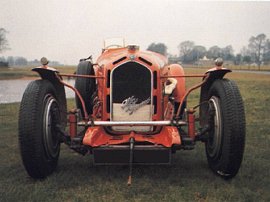
The 1920 Závodní
Speciál was a clear indication that Alfa
had its sights set on the manufacture of sports
cars...
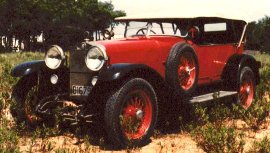
The earliest sporting Alfa's
were the 22/90's, or RLSS models - the 'SS'
standing for 'Super Sport'...

In a true David and Goliath battle,
the wonderful 1750 would shame the 7 litre/225bhp
supercharged Mercedes-Benz SSK by more than
one hour in the 1930 1000-mile Italian Mille Miglia...

The 1936 AC 2900 had a straight
eight engine, effectively created by joining
2 4-cylinder units back-to-back...
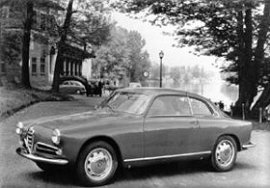
The 1954 Giulietta Sprint ensured
Alfa's survival after the war...

The now rare Giulia GTC Spider
that featured a 1.6 litre twin-cam engine...
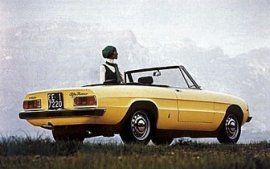
The 1750 Spider Veloce was attractive
from any angle...
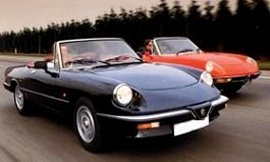
The pretty Spider would remain
on sale into the early 1990's...
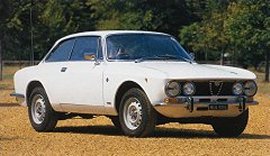
The GTV1750 was an overnight
success...
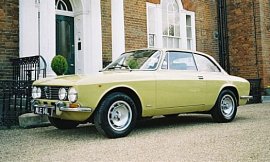
Alfa were to replace the extremely
popular 1750 with the GTV2000, unfortunately
this would be the last of the line of this truly
great sports coupe...

The Montreal was good for over
130mph...

The Alfasud was meant to make
Alfa one of the worlds largest automobile manufacturers,
today it is remembered for its reliability issues
and relentless rust...
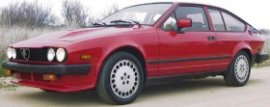
The GTV6 went a long way to re-establishing
Alfa's reputation, particularly because of its
sublime V6 engine... |
The Legend Of The 1750
In 1928 Nicola Romeo was removed as Director and the company passed into government receivership shortly after the crash. Undaunted, the engineers continued to work at improving their wonderful Gran Turismo models and, in 1929, they enlarged the twin-cam's engine capacity to 1752cc. Vittoria Jano then used the Gran Turismo's basic chassis and running gear to create a new model - one that would became somewhat of a legend, the famed "1750".
Praised by those that were lucky enough to see and drive it, the modern "masterpiece" was destined to become an extremely competent competition vehicle. The gear-change was extremely positive, the
steering precise, and the roadholding excellent. Of the various types of 1750, the Gran Sport and the Super Sport were the most exciting, and these were often provided with elegant, attractive body styles by coachbuilders like Zagato and Touring.
One measure of the 1750's capabilities was proved in the 1000-mile Italian
Mille Miglia of 1930, where
Tazio Nuvolari's 'blown' 1750 would win the race outright, beating such cars as the 7-1itre/225bhp supercharged Mercedes-Benz SSK by more than one hour. Inevitably, more power was needed for the next generation of cars, so Jano was encouraged to produce a new engine, choosing a mighty 2336cc straight eight-cylinder unit that coincidently used the same bore and stroke dimensions as the 1752cc six.
Like the six, the new eight had twin overhead camshafts, but to overcome torsional vibration and strength problems in using such a long engine, he arranged it effectively as two four-cylinder engines back to back.
There were separate cylinder blocks on a common crankcase, and the crank ran an astounding 10 main bearings to keep it all as rigid as possible. As before, there was a Roots-type supercharger, mechanically driven by gears from the centre of the crankshaft, drawing the fuel/air mixture through a Memini carburettor.
Success At The Mille Miglia, Targa Florio and Le Mans
The engine was good for a whopping 138bhp at 5000rpm The chassis was still flexible, but at least this was balanced by the use of rock hard front and rear leaf springs. At the front axle, there was extra location by radius arms, and in true Alfa Romeo style the
steering was light, while
handling was exciting but predictable. The new car was dubbed the "8C 2300", and was offered either as the Lungo, the LWB (long-wheelbase) 10ft 4in Le Mans, or either of the 9ft Corto or
Mille Miglia.
The 8C 2300's braking was much improved over the 1750, thanks largely to the fitment of very large finned alloy brake drums. On the downside however the clutch operation was very difficult and needed to be mastered by an expert. Competition success was almost a surety, and after its 1931 launch it would notch up wins immediately at the
Targa Florio and
Le Mans 24 Hour race. Two famous evolutions of the 8C 2300 were the 2556cc open-wheeler two seater racing "Monza" model, and the Tipo B (or "P3")
Grand Prix car of 1932.
But while Alfa rose to dominance on the racetrack, so to did the ruling fascist government. In 1934 Alfa would be absorbed with other industrial companies by the Instituto di Riconstruzzione Industriale (IRI) - an agency of the fascist government. Despite the political upheaval pervading the company, they were able to release the
8C 2900 model in 1936. Using a 2906cc engine that had been developed from the extremely successful P3 single-seaters, the car was produced in both racing and short wheelbase touring forms.
The "Touring" model used a de-tuned 2.9 litre race engine with twin superchargers and twin Weber carburettors, producing an astonishing 180bhp at 5000rpm. Other modern features included the use of hydraulic brakes, hydraulic front dampers and independent coil spring front suspension.
Ultimately there would be two factors working against the 8C 2900, the price and the war. After some 2 years Alfa had only been able to sell 30 vehicles, although under the IRI's control the manufacture of motor vehicles was seen as far less important then the manufacture of weapons.
The Ravages Of War
When war finally broke out on September 1st, 1939 partially-assembled production vehicles were put in storage and a few racing and experimental cars were hidden in caves north of Milan. The war was a disaster for Italy and for Alfa. Occupying German troops commandeered part of what remained of the severely damaged factory, but its continued weapons manufacture would make it a target for allied bombers. By the end of the war the Milan factory was entirely destroyed.
After the war, the design team worked through the destruction to develop a different kind of Alfa Romeo for the changed Europe that lay ahead. A completely new passenger car, the Alfa Romeo 1900, was introduced in
1950 followed by the Giulietta in
1954 - and it is these cars that essentially mark the beginning of the modern era in Alfa Romeo's history.
Although the 1900 sold well, particularly by Alfa standards, the company new that to successfully expand they would need to manufacture a small engined car - cheap to manufacture, purchase and run - factors very important in post war Europe.
Every car in the Giulietta family had the same type 1290cc twin-cam four-cylinder engine, of almost 'traditional' Alfa Romeo layout. Bore and stroke dimensions were nearly the same, breathing was efficient, and the engine revved easily to 7000rpm. Instead of a separate chassis, the Giuliettas were all based on a unit construction body/chassis design.
There was coil spring and wishbone independent front suspension with an
anti-roll bar, while the rear axle, though sprung on coils, had a complicated location which included trailing arms and an A-bracket linking the floor pan to the differential casing.
The Bread-And-Butter Sprint
The Sprint became the 'bread and butter' model in the range, and featured a beautiful body styled by
Bertone and offered four seats under the coupe roof. The engine produced a healthy 80bhp, and gave the Sprint a top speed of almost 100mph.
A year later, the Sprint was joined by the
Pininfarina-styled open two-seater Spider, and although its wheelbase was some 5 inches shorter it shared the same running gear. A year later higher-performance (90bhp) versions of these cars were announced, and given the model names Sprint Veloce and Spider Veloce; both were capable of 110mph.
The Influence Of Bertone
In the late 1950's the Sprint Speciale (styled by
Bertone) and Sprint Zagato were released. Both cars were fitted with 100bhp engines and were mated to a five-speed transmission making them capable of completing the 0-60mph dash in less than ten seconds, while achieving a top speed of around 120mph. In 1962, the Giulietta was progressively succeeded by the Giulia range, which used much the same running gear and suspension, but which had its engine 'stretched' to 1570cc.
The Giulia TI saloon had a boxy style, a single carburettor version of the engine and was good for a top speed of around 100mph. At first there were interim sporting models - both the Giuliettas getting the larger engine and becoming Giulia Sprint and Giulia Spider respectively.
The definitive sporting Giulias, however, were the Sprint GT of 1963 (with 106hp, five-speed transmission and gorgeous styling by Berlone), and the controversially styled 1600 Duetto Spider (with used the same running gear as the Sprint GT but had a
Pininfarina styled body.
The ensuing years would see many derivatives of the two styles being produced, not the least of which was the lightweight Giulia GTA, the 115bhp 'homologation special.' In 1970 the Duetto's styling would became even more conventional with the tail being cut short, the car now being known simply as 'Spider'. Over the years engine sizes would vary/increase from 1290cc to 1962cc, but all were of the same twin-cam family, and the Alfa model line-up being marketed in a bewildering number of guises, the Spider still being sold in the USA in the mid-1980s!
The most remarkable Giulia of all was the GTZ (Z = Zagato) Tubulare, which had an entirely special multi-tube space frame chassis, and light-alloy body style, but the familiar
The Beautiful Montreal
Indeed the interest in the vehicle was such that Alfa decided to put the car on sale in 1970. Based on the Giulia GT7s floorpan and suspensions, the Montreal was powered by a de-rated, 200hp, version of the four-cam V8 engine already used in the Type 33 racing sports-cars, and in this form it had a 2593cc engine with fuel injection. Built in limited numbers until 1977, it was available with right-hand-drive from 1974. In standard form, the Montreal had a top speed of 136mph.
In 1972 Alfa would attempt to become one of the worlds largest
automobile manufacturers, and the product that would propel them toward these dizzy heights was the new ‘affordable’
Alfasud. Manufactured in Alfa’s new factory in South Italy, (hence the name Alfasud - "Alfa South"), Alfa Romeo invested in new technologies in an attempt to take the more mainstream car manufacturers head on, utilising technologies such as
front wheel drive and MacPherson strut suspension.
But undoubtedly the highlight was the new boxer engine (horizontally-opposed/flat engine). Although only a single cam rather than the twin cam designs of other Alfa's, it had superior smoothness and its responsiveness earned it the reputation of being the sweetest engine available in the class for more than a decade. But voracious
rust and build quality problems would quickly tarnish the cars reputation, and many consider the little Alfasud more a lemon than a leader.
The Return of the Masterpiece
By 1979 Alfa would return to manufacturing true sporting masterpieces, such as the
GTV6. The engineering excellence of this vehicle, particularly the silky-sweet V6 engine, would help re-establish the reputation of this truly great
automobile manufacturer.
Until the 1980s, Alfa Romeos, except for the Alfasud, were rear-wheel-drive. According to the current Fiat CEO Sergio Marchionne in order to reap economies of scale, all new Alfa Romeo models will be made from the same basic platform (i.e., frame). Even Maserati share csome omponents with some Alfas.
The Alfettas of the early 1980s had models available sold as the "Silver Leaf" and "Gold Leaf" (Quadrifoglio Oro). These models were the top of the range. Badging was the Alfa Cloverleaf in either gold or silver to denote the specification level. The Gold Leaf model was also sold as the "159i" in some markets, the name in homage to the original 159.
During the 1990s, Alfa Romeo moved car production to other districts in Italy. The Pomigliano d’Arco plant produced the 155, followed by the 145 and the 146, while the Arese plant manufactured the 164 and new Spider and GTV. The 156 was launched in 1997, and became quite successful for Alfa Romeo; in 1998 it was voted “Car of the Year”. The same year a new flagship, the 166 (assembled in Rivalta, near Turin) was launched. The 147 followed, winning the prestigious title of “Car of the Year 2001”.
In 2003 the Arese factory was closed - today it houses the Alfa Romeo Historical Museum, a must-see for Alfa Romeo fans.
Also See: Alfa Romeo Car Reviews |
The History of Alfa Romeo (USA Edition) 


